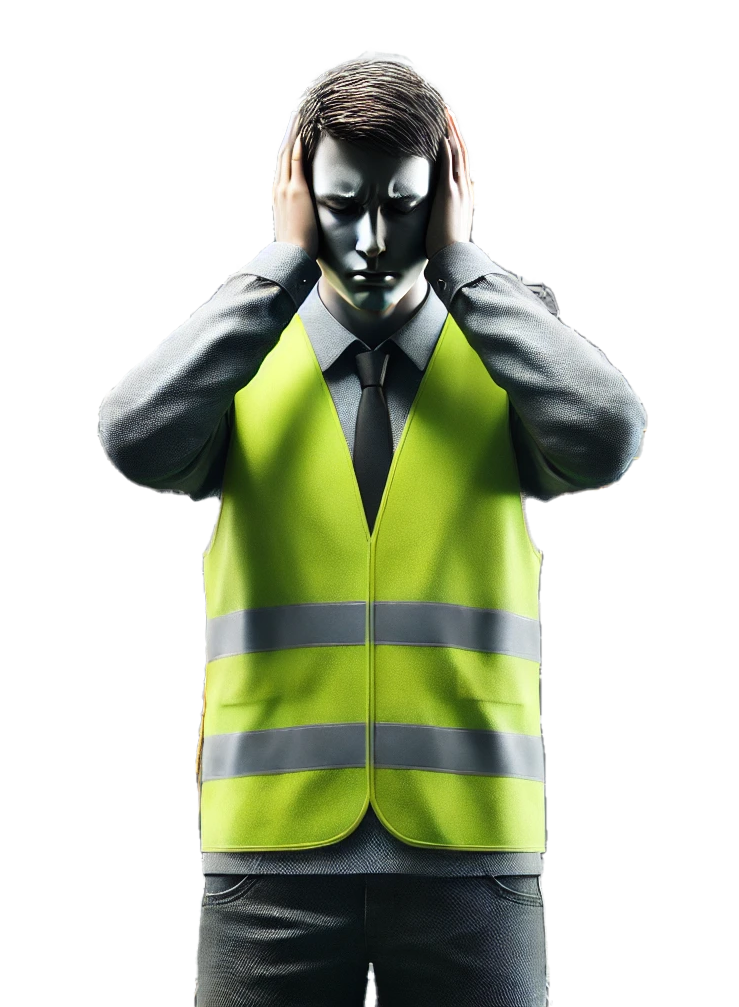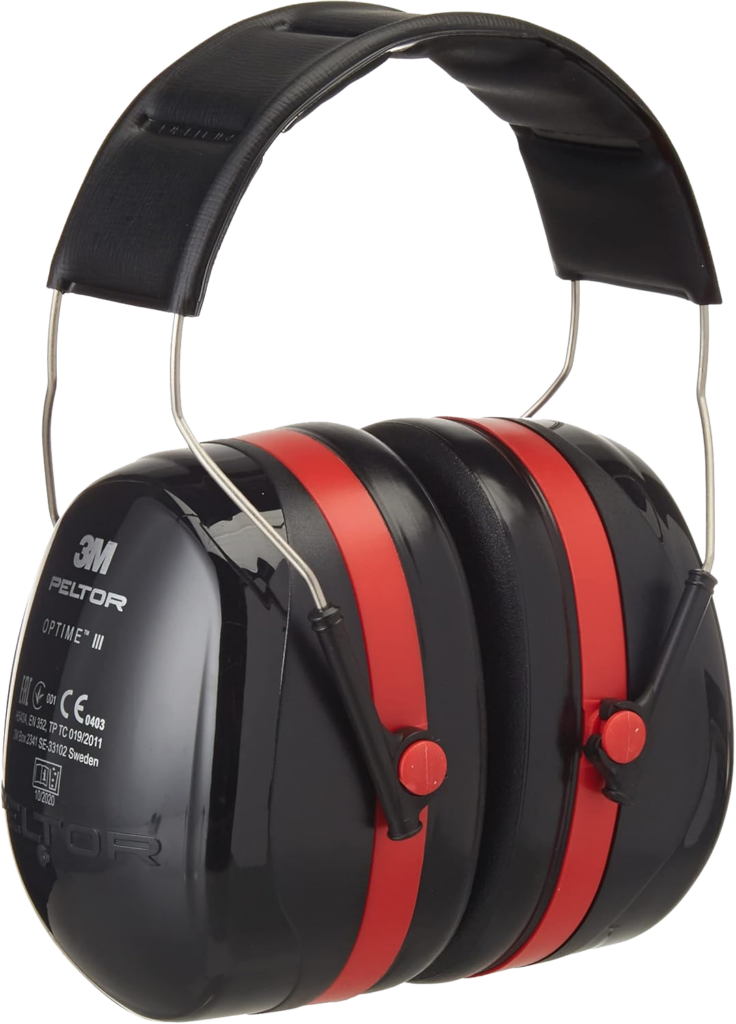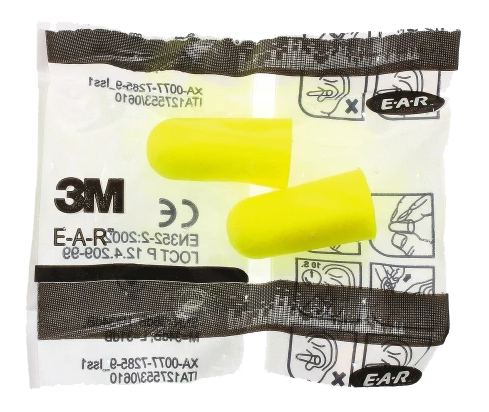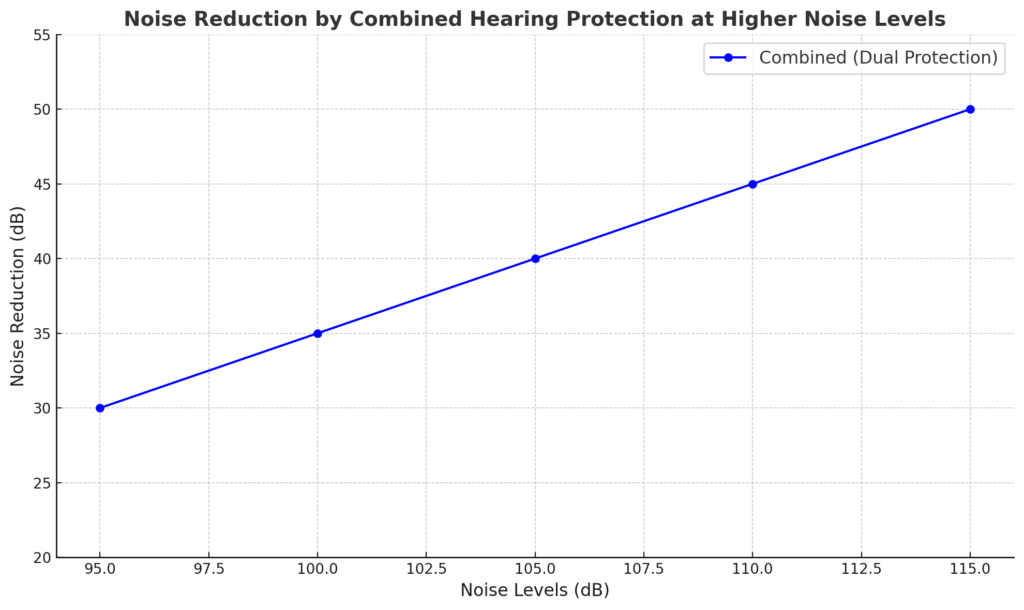
Noise is debilitative. Fact, so lets protect people.
In environments where noise levels exceed safe thresholds, hearing protection is not just a recommendation—it’s a necessity.
Understanding the regulations, tests, and best practices is essential to ensure compliance and safeguard workers’ hearing. This article outlines key standards, practical measures, and the steps to take when sound levels exceed safe limits, including guidance on noise assessments, dual hearing protection, and a simple explanation of the math behind combining protection.
This page is best viewed on desktop.
At a glance. Safe Thresholds practical example.
| Noise Level (dB) | Examples | Safe Exposure Time Without Protection | Protection Guidance |
|---|---|---|---|
| 60-70 | Normal conversation | Unlimited | No protection needed |
| 80 | Traffic noise, loud office | Up to 8 hours | Provide protection upon request |
| 85 | Busy factory floor | Up to 8 hours | Protection mandatory if exposure exceeds this time |
| 90 | Lawnmower, forklift | Up to 2 hours | Hearing protection strongly recommended |
| 95 | Circular saw, motorcycle | Up to 1 hour | Protection mandatory,Dual protection recommended |
| 100 | Chainsaw, jackhammer | Up to 15 minutes | Protection mandatory,Dual protection recommended |
| 105 | Rock concert, helicopter | Up to 4 minutes | Dual protection recommended |
| 110 | Sirens, compressed air | 1 minute or less | Dual protection required |
| 115 | Jet engine, firecrackers | Immediate damage threshold | Protection must be used at all times |
Noise Regulations and Standards
Noise-induced hearing loss is a significant occupational hazard. In the UK, compliance with the following regulations and standards is critical:
Control of Noise at Work Regulations 2005
Employers are legally required to prevent or reduce risks from exposure to noise at work. Specific duties include:
- Assessing the risks of noise exposure: Identifying where noise poses a risk and quantifying exposure levels.
- Reducing noise levels at the source wherever possible: Implementing engineering and administrative controls.
- Providing appropriate hearing protection and ensuring it is effective: Supplying hearing protectors where noise cannot be sufficiently reduced.
British Standards (BS)
- BS EN 352-1:2002: Specifies the requirements for earmuffs.
- BS EN 458:2016+A1:2020: Offers guidance on selecting, using, and maintaining hearing protectors.
- BS EN ISO 4869: Details methods for measuring the sound attenuation of hearing protectors.
BS EN 352-1:2002 – Specifications for Earmuffs
This standard outlines the key requirements and performance characteristics for earmuffs used as personal hearing protection. It ensures that earmuffs meet safety, durability, and attenuation criteria suitable for protecting workers in noisy environments.
Key Aspects of BS EN 352-1:2002:
Attenuation Requirements: Earmuffs must reduce noise exposure to levels below the upper exposure action value (85 dB(A)) in compliance with noise control regulations.
Physical Durability: The standard specifies that earmuffs must withstand environmental factors such as heat, moisture, and repeated use without compromising performance.
Comfort and Fit: Earmuffs must provide a secure yet comfortable fit to encourage prolonged use, ensuring effective attenuation over extended periods.
Marking and Labeling: Earmuffs must include clear markings indicating their Noise Reduction Rating (NRR), model identification, and compliance with BS EN 352-1:2002.
Testing Protocols: The standard defines rigorous testing procedures to verify the earmuffs’ attenuation performance, stability under pressure, and resistance to environmental degradation.
BS EN 458:2016+A1:2020 – Guidance on Hearing Protector Selection and Maintenance
This comprehensive standard provides essential guidance on the selection, use, care, and maintenance of hearing protection devices (HPDs). It is designed to help employers and safety professionals match appropriate protectors to specific noise hazards and ensure their ongoing effectiveness.
Key Provisions of BS EN 458:2016+A1:2020:
Selection of Hearing Protectors:
Hearing protectors must be chosen based on workplace noise levels, individual worker needs, and compatibility with other PPE (e.g., helmets, goggles).
Overprotection should be avoided as it can lead to communication difficulties and worker isolation, reducing compliance.
Fit and Comfort:
Ensures protectors are ergonomically designed for prolonged wear without causing discomfort.
Highlights the importance of proper fitting, training workers to use HPDs correctly, and monitoring their use in the workplace.
Dual Protection Guidance:
Advises on combining earplugs and earmuffs for environments exceeding 105 dB(A), ensuring additional attenuation without compromising usability.
Maintenance and Lifespan:
Recommends regular inspection and replacement of worn or damaged protectors.
Provides cleaning guidelines to maintain hygiene and performance.
Communication Needs:
Recommends hearing protectors with passive filters or active noise-canceling technology for environments where workers need to hear speech or warning signals.
Training and Monitoring:
Encourages regular training programs to ensure workers understand the importance of correct use.
Suggests periodic monitoring to verify that HPDs are providing adequate protection.
BS EN ISO 4869 – Measuring the Sound Attenuation of Hearing Protectors
This standard outlines the methods used to assess the noise reduction capabilities of hearing protectors, such as earplugs, earmuffs, and communication headsets. By providing a consistent framework for measuring sound attenuation, BS EN ISO 4869 ensures that hearing protection devices (HPDs) meet established performance requirements and provide reliable noise reduction in real-world conditions.
Key Components of BS EN ISO 4869:
Standardised Testing Methods:
Specifies laboratory-based procedures for measuring the attenuation provided by hearing protectors across a range of frequencies (typically from 63 Hz to 8000 Hz).
Testing is conducted under controlled conditions to determine how much noise the device reduces at each frequency.
Single Number Ratings:
Derives practical single-number ratings such as SNR (Single Number Rating) or NRR (Noise Reduction Rating) to make it easier for employers and users to compare products and select appropriate protectors for specific noise levels.
These ratings are designed to be user-friendly and provide clear guidance on the level of protection expected.
Real-Ear Attenuation at Threshold (REAT):
One of the core methods used in this standard, REAT measures the difference in hearing thresholds with and without the hearing protector, providing an accurate estimate of its effectiveness.
Testing involves human participants and ensures protectors are assessed in conditions that mimic actual use.
H-M-L Ratings:
Introduces High (H), Medium (M), and Low (L) frequency attenuation ratings to provide detailed insights into how well a protector performs across different noise frequencies, helping employers match protectors to specific noise profiles.
Application in Risk Assessments:
The data generated using BS EN ISO 4869 helps employers:
Select hearing protectors suitable for specific noise environments.
Ensure compliance with noise control regulations by verifying that the selected protection meets exposure reduction goals.
Limitations and Real-World Adjustments:
While laboratory conditions provide reliable baseline attenuation figures, the standard acknowledges that real-world performance may vary due to factors like improper fit, wear, and environmental conditions.
Employers are encouraged to account for potential discrepancies and implement training to ensure proper use.
Key Exposure Action Values
- Lower exposure action value: 80 dB(A) (daily or weekly average).
- Upper exposure action value: 85 dB(A).
- Peak sound pressure: 135 dB(C).
When Sound Levels Exceed Safe Limits
When noise levels exceed the lower action value of 80 dB(A), employers must implement a hierarchy of control measures:
1. Risk Assessment and Monitoring
Conduct regular noise assessments using calibrated sound level meters.
Identify tasks and equipment contributing to high noise levels.
2. Engineering Controls
Replace or modify noisy equipment to reduce sound emissions.
Use barriers, enclosures, or absorbent materials to dampen sound.
3. Administrative Controls
Rotate workers to limit exposure time.
Designate and enforce hearing protection zones with clear signage.
4. Personal Protective Equipment (PPE)
Provide suitable hearing protection, such as:
Earmuffs (BS EN 352-1).
Earplugs (BS EN 352-2).
Ensure protectors are appropriate for the level of exposure.
Typical Example DB to Application Table
| Noise Level (dB) | Example Application | Recommended Protection |
|---|---|---|
| 80-85 dB | Office with loud equipment | None required (monitor noise levels) |
| 85-95 dB | Factory floor | Earplugs or earmuffs |
| 95-105 dB | Heavy machinery operation | Earmuffs with high attenuation rating |
| 105-115 dB | Mining or aviation ground crew | Dual protection: earplugs + earmuffs |
| >115 dB | Explosions, jet engines | Dual protection and restrict exposure time |
When in Doubt: Testing Noise Levels
If you are uncertain about workplace noise levels, conducting a noise assessment is essential to ensure hazards are correctly identified and addressed.
How to Measure Noise Levels
- Sound Level Meters (SLMs): Measure sound pressure levels in specific locations.
- Noise Dosimeters: Worn by workers to measure individual exposure over time.
- Integrating SLMs: Provide time-averaged noise levels, which are critical for assessing exposure action values.
Steps for Conducting Noise Testing
- Identify Noise Sources: Map out noisy equipment, tasks, or processes.
- Measure Noise Levels: Take readings at ear height for accurate exposure levels.
- Analyse Data: Compare results to action values (80 dB(A) and 85 dB(A)).
- Implement Controls: Use the hierarchy of controls to address excessive noise.
Big Question: Fit Testing: Legal or Not?
Fit testing is not legally required under the Control of Noise at Work Regulations 2005. However, L108: Controlling Noise at Work strongly emphasises ensuring hearing protection is effective for each individual worker. This includes:
- Proper selection of hearing protectors to match the noise environment.
- Training workers to use protectors correctly.
- Supervising usage to ensure continued compliance.
Combining Hearing Protectors for Maximum Protection
In environments exceeding 105 dB(A), dual hearing protection—combining earplugs and earmuffs—may be necessary. This approach provides additional attenuation, especially in high-noise industries like mining or aviation. Below gives a few examples in various ways to get across the combination method.
Remember: This is all dependant on reducing the risk if possible. Be it trough Engineering or Administrative means. Getting that noise level down somehow is key rather than relying on PPE to do so. If this is not possible then of course the PPE is one of the major factors here.


Simplified Explanation of Combined Noise Reduction
The combined noise reduction of earplugs and earmuffs is not simply additive. Instead:
- Start with the higher Noise Reduction Rating (NRR) between the two devices.
- Add approximately 5 dB for the second device to account for its additional protection.
Example Calculation
- Earplugs NRR: 25 dB
- Earmuffs NRR: 20 dB
Result: The combined noise reduction is approximately 30 dB. For environments exceeding 105 dB(A), this combined approach is critical for safety.
Another way of posing it.
When calculating the total noise reduction from using two hearing protection devices (earplugs and earmuffs), you always start with the device that has the higher Noise Reduction Rating (NRR), as it provides the primary level of protection.
The second device adds additional attenuation, but not its full NRR, because noise reduction follows a logarithmic scale. For example, if earplugs have an NRR of 25 dB and earmuffs have an NRR of 20 dB, you start with 25 dB (the higher NRR) and add about 5 dB from the second device, resulting in a combined reduction of approximately 30 dB.
This method applies regardless of which device has the higher NRR, as the most effective protector always forms the baseline.
Visual Guide: Noise Reduction by Protection Type
Below is a chart illustrating the effectiveness of combined hearing protection at increasing noise levels:

Here’s a practical table for typical combinations of earplugs and earmuffs, showing how the total noise reduction is calculated when combining devices. This may be useful for acquiring equipment, notice how the levels correlate with the chart.
| Noise Level (dB) | Device 1 | NRR (dB) | Device 2 | NRR (dB) | Combined Noise Reduction (dB) |
|---|---|---|---|---|---|
| 95 | Earplugs | 20 | Earmuffs | 25 | 30 |
| 95 | Earmuffs | 20 | Earplugs | 25 | 30 |
| 100 | Earplugs | 25 | Earmuffs | 30 | 35 |
| 100 | Earmuffs | 25 | Earplugs | 30 | 35 |
| 105 | Earplugs | 30 | Earmuffs | 35 | 40 |
| 105 | Earmuffs | 30 | Earplugs | 35 | 40 |
| 110 | Earplugs | 35 | Earmuffs | 40 | 45 |
| 110 | Earmuffs | 35 | Earplugs | 40 | 45 |
| 115 | Earplugs | 40 | Earmuffs | 45 | 50 |
| 115 | Earmuffs | 40 | Earplugs | 45 | 50 |
Note to 40db NRR when you are in this audible level specialist assistance from 3rd party suppliers and H&S representatives is required. This table is purely for illustrative purposes. Remember first port of call is “can you reduce the noise” by Engineering / Administrative means or other.
How the Table Works
- Device 1 and Device 2: These are the hearing protectors being combined (either earplugs or earmuffs).
- NRR (dB): The Noise Reduction Rating for each device.
- Combined Noise Reduction: Start with the higher NRR and add ~5 dB for the second device.
Wrapping up. Noise is unpleasant.
Protecting hearing in noisy environments is a legal and ethical responsibility. While fit testing is not mandated by law, it is a best practice recommended in L108: Controlling Noise at Work to ensure protectors provide adequate attenuation for each worker. By adhering to the Control of Noise at Work Regulations 2005, BS standards, and HSE guidance, employers can create safer workplaces and prevent irreversible hearing damage. If in doubt get a professional to help and assist with advice.
For more detailed guidance, refer to the HSE’s Noise at Work Guidance and relevant British Standards.g accurate noise testing, effective hearing protection, and robust training ensures workers’ safety in the long term.
Relevant Links
Controlling noise at work – L108
Disclaimer:
The information provided on this site is for general informational purposes only and may not reflect the most current regulations or standards. Legislation, industry guidelines, and best practices can change over time, and it is the user’s responsibility to research and ensure compliance with the latest requirements for their specific situation. Always consult a qualified professional for advice tailored to your project or application.
